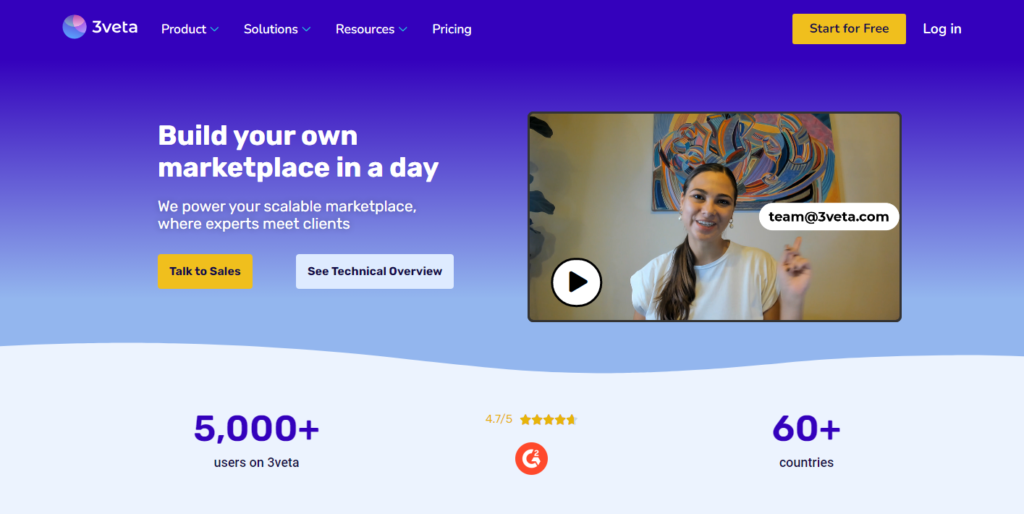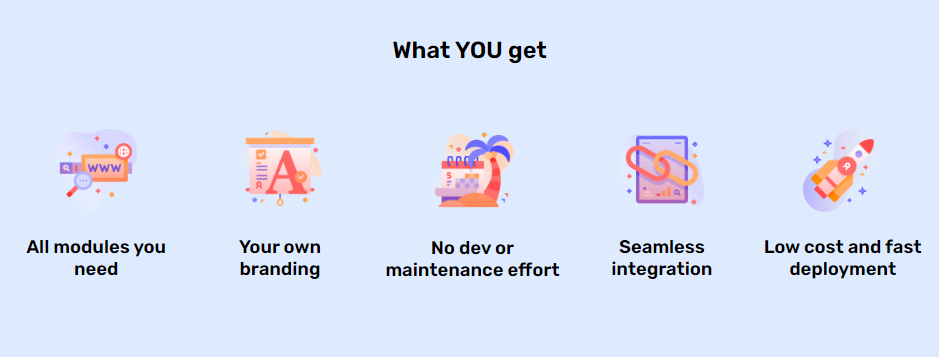Service marketplaces are the number one go-to for customers that want variety, good quality, and security as well as for professionals who want to reach a larger audience.
From home trade and repairs to coaching and tutoring lessons, marketplaces have found their place within almost every industry. As a marketplace owner, your task is to find the most promising niche and start building your business.
You may have certain preconceived ideas that to create a marketplace website you must have programming skills and a lot of savings since it will be expensive.
In fact, a custom-made marketplace can be done without any of these scary misconceptions.
How? Read along!
Can I create a marketplace?
You can! No matter if you’re a top-tier programmer or a computer-work-on-magic believer.
Your tech skills are somewhat irrelevant since there are online marketplace solutions (like 3veta) that do all the programming (a.k.a. the magic) instead of you!

No-code solutions are extremely convenient, as HBR states, because you don’t have to sit the whole day, weeks in a roll, trying to figure out why the code is not working and being frustrated that your website is not that functional.
Instead, you can choose from a list of modules offered by the no-code marketplace builder that will compile a bunch of template codes to build your custom-made marketplace!
In the meantime, you can focus on developing your idea, figuring out the details, and planning the next steps.
Of course, all the basics such as figuring out the niche, finding your target audience, and choosing the right business model have to be taken care of in advance.
But once your initial idea is realized and undergone successful MVP testing, you can focus on recruiting more professionals to join your platform, getting insights from marketplace analytics, and investing in better marketing.
You might also want to know what you should be wary of so let’s dive deeper into the possible shortcomings.
💡 Pro tip
Wondering what your service marketplace will look like? Play with our interactive demo and find out!

7 challenges for marketplace entrepreneurs
Now, there are many difficulties that entrepreneur newbies inevitably face. We’ll cover the basics in regard to professional services marketplaces.
Here are 7 of the most common challenges that you have to take into account when starting your marketplace business.
Product/market fit
Achieving a good product-market fit would require extensive research into your target audience and their needs to develop and deliver a product that satisfies their expectations.
Product-market fit is a critical concept for any start-up or business, as it is often the key determinant of success.
Why? Because it proves that there is a blank spot in the market niche of your choice and your business idea can fill it up. Meaning that people will be willing to pay for your services!
Budget
When starting from scratch every custom marketplace entrepreneur should keep one thing in mind – marketplace development is extremely expensive unless you find a no-code solution.
Of course, no-code has its own downsides but when compared to the benefits, they turn out to be outnumbered, outweigh, surpassed, overshadowed… You get the idea.
It’s cheaper, it’s faster, it’s waaay easier and you can spend your budget on advertising that would spread the word about your product.
Technical expertise
If you don’t use an online marketplace builder, you’d have to either code everything from scratch yourself or hire a team of devs to do it for you.
But, again, why would you prefer to give thousands of hundreds of dollars for months to build a website that could be ready to use in 3 to 5 business days?
And, after it’s done, the online marketplace builder you’ve used will be responsible for software updates and general maintenance.

User experience
Especially in the beginning, your number one priority should be to improve the UX of your platform.
By improving your services, you ensure customer and seller retention in the marketplace and you show that you value feedback.
At first, your custom marketplace won’t be perfect and won’t be the most optimal version of itself. That happens over time. But the road towards achieving ideal performance goes through trial and error.
And to see what works and what doesn’t, you need marketplace analytics that will show you in charts and diagrams different aspects of your performance and user engagement.
Inflexible user flows
Adam Fard explains what user flows are in a couple of simple sentences:
“A user flow is a path users take to complete a certain task. This path includes the journey from the entry (like login) to the task completion (like creating a profile).”
The issue is that oftentimes, the user’s journey through a digital product or service is restricted or limited by predetermined, rigid pathways. This means that the user has little or no ability to deviate from the pre-determined sequence of actions that the designer or developer has created for them.
This could be frustrating for users, particularly if they need to perform tasks that require flexibility or creativity.
To avoid such poor user experience and reduced engagement, one should strive to create user journeys that are intuitive and easy to navigate, while also allowing for flexibility and personalization.
Low scalability
Low scalability is when the system supporting your business is limited in its ability to accommodate growth and may start to experience performance issues or other problems as the workload grows.
For example, if your website was designed to handle a few hundred users per day, it may start to experience performance issues as the user base grows to thousands or tens of thousands.
That’s why our online marketplace builder supports continuous backups and system updates such as software and feature add-ons.
Limited features
Depending on the type of custom marketplace you’re running – business-to-business, business-to-customer, or peer-to-peer, your platform would require specific features.
Many online marketplace solutions offer the most basic service marketplace features but some fail to deliver the full spectrum of modules.
It’s not simply about creating a website that allows sellers to list their services and customers to browse through all listings. It’s also about payments, personalization (Is your branding properly displayed?), video conferencing and scheduling, as well as marketplace analytics.
You may think that these features could be delivered by third-party software and you’re right. But isn’t it the whole point to have everything you and your clients need in one place?
What is the best customizable marketplace software?
As we said, there are many online marketplace solutions on the market. Each one has its own pros and cons and it may take a while to go over all of them. But we have a word limit to comply with.
So, instead of talking about others, we’ll do what we know best – we’ll explain how 3veta can help you on your journey as a custom marketplace owner.

We define ourselves as a white-label no-code marketplace builder. Sounds complicated, I know. But you’re already familiar with the term no-code.
White-label means that we don’t insist on replacing your logo with ours, in fact, we prefer it to be the other way around. Also, we encourage personalization; let’s use your brand colors when we build the website.
Our initial services were entirely dedicated to video conferencing and scheduling so we’ve got you covered there as well.
But you can choose whatever features you’d like from our list of modules and if something isn’t in there yet we can definitely talk about it.

We also don’t like to procrastinate, you can have your custom marketplace up and running in less than a week.
Is that all?
For this piece of writing, yes.
We’ve tried to encourage you to believe in your capabilities to build a custom marketplace yourself without going bankrupt.
We also did our best to warn you about the possible difficulties you may encounter.
And we also gave you a solution to those challenges – 3veta, the online marketplace builder.
Feeling intrigued? We’d love to hear more about your idea!
